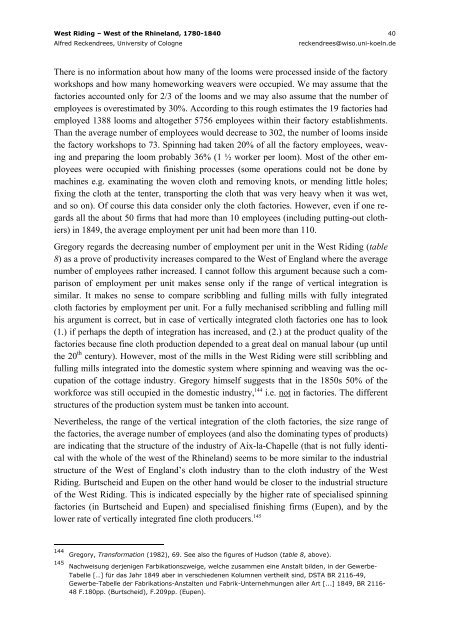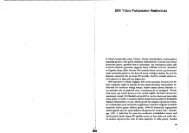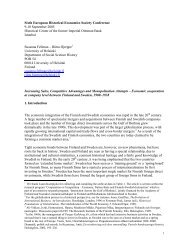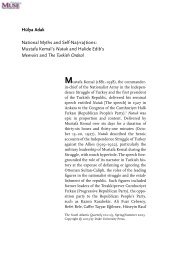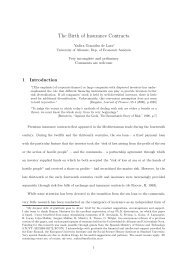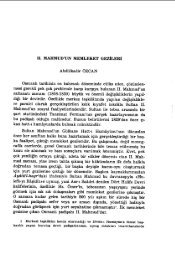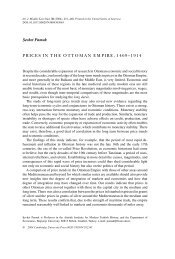West Riding – Western Rhineprovince, 1790-1840: Diverse Paths to ...
West Riding – Western Rhineprovince, 1790-1840: Diverse Paths to ...
West Riding – Western Rhineprovince, 1790-1840: Diverse Paths to ...
You also want an ePaper? Increase the reach of your titles
YUMPU automatically turns print PDFs into web optimized ePapers that Google loves.
<strong>West</strong> <strong>Riding</strong> <strong>–</strong> <strong>West</strong> of the Rhineland, 1780-<strong>1840</strong> 40<br />
Alfred Reckendrees, University of Cologne reckendrees@wiso.uni-koeln.de<br />
There is no information about how many of the looms were processed inside of the fac<strong>to</strong>ry<br />
workshops and how many homeworking weavers were occupied. We may assume that the<br />
fac<strong>to</strong>ries accounted only for 2/3 of the looms and we may also assume that the number of<br />
employees is overestimated by 30%. According <strong>to</strong> this rough estimates the 19 fac<strong>to</strong>ries had<br />
employed 1388 looms and al<strong>to</strong>gether 5756 employees within their fac<strong>to</strong>ry establishments.<br />
Than the average number of employees would decrease <strong>to</strong> 302, the number of looms inside<br />
the fac<strong>to</strong>ry workshops <strong>to</strong> 73. Spinning had taken 20% of all the fac<strong>to</strong>ry employees, weaving<br />
and preparing the loom probably 36% (1 ½ worker per loom). Most of the other employees<br />
were occupied with finishing processes (some operations could not be done by<br />
machines e.g. examinating the woven cloth and removing knots, or mending little holes;<br />
fixing the cloth at the tenter, transporting the cloth that was very heavy when it was wet,<br />
and so on). Of course this data consider only the cloth fac<strong>to</strong>ries. However, even if one regards<br />
all the about 50 firms that had more than 10 employees (including putting-out clothiers)<br />
in 1849, the average employment per unit had been more than 110.<br />
Gregory regards the decreasing number of employment per unit in the <strong>West</strong> <strong>Riding</strong> (table<br />
8) as a prove of productivity increases compared <strong>to</strong> the <strong>West</strong> of England where the average<br />
number of employees rather increased. I cannot follow this argument because such a comparison<br />
of employment per unit makes sense only if the range of vertical integration is<br />
similar. It makes no sense <strong>to</strong> compare scribbling and fulling mills with fully integrated<br />
cloth fac<strong>to</strong>ries by employment per unit. For a fully mechanised scribbling and fulling mill<br />
his argument is correct, but in case of vertically integrated cloth fac<strong>to</strong>ries one has <strong>to</strong> look<br />
(1.) if perhaps the depth of integration has increased, and (2.) at the product quality of the<br />
fac<strong>to</strong>ries because fine cloth production depended <strong>to</strong> a great deal on manual labour (up until<br />
the 20 th century). However, most of the mills in the <strong>West</strong> <strong>Riding</strong> were still scribbling and<br />
fulling mills integrated in<strong>to</strong> the domestic system where spinning and weaving was the occupation<br />
of the cottage industry. Gregory himself suggests that in the 1850s 50% of the<br />
workforce was still occupied in the domestic industry, 144 i.e. not in fac<strong>to</strong>ries. The different<br />
structures of the production system must be tanken in<strong>to</strong> account.<br />
Nevertheless, the range of the vertical integration of the cloth fac<strong>to</strong>ries, the size range of<br />
the fac<strong>to</strong>ries, the average number of employees (and also the dominating types of products)<br />
are indicating that the structure of the industry of Aix-la-Chapelle (that is not fully identical<br />
with the whole of the west of the Rhineland) seems <strong>to</strong> be more similar <strong>to</strong> the industrial<br />
structure of the <strong>West</strong> of England’s cloth industry than <strong>to</strong> the cloth industry of the <strong>West</strong><br />
<strong>Riding</strong>. Burtscheid and Eupen on the other hand would be closer <strong>to</strong> the industrial structure<br />
of the <strong>West</strong> <strong>Riding</strong>. This is indicated especially by the higher rate of specialised spinning<br />
fac<strong>to</strong>ries (in Burtscheid and Eupen) and specialised finishing firms (Eupen), and by the<br />
lower rate of vertically integrated fine cloth producers. 145<br />
144 Gregory, Transformation (1982), 69. See also the figures of Hudson (table 8, above).<br />
145<br />
Nachweisung derjenigen Farbikationszweige, welche zusammen eine Anstalt bilden, in der Gewerbe-<br />
Tabelle […] für das Jahr 1849 aber in verschiedenen Kolumnen vertheilt sind, DSTA BR 2116-49,<br />
Gewerbe-Tabelle der Fabrikations-Anstalten und Fabrik-Unternehmungen aller Art [...] 1849, BR 2116-<br />
48 F.180pp. (Burtscheid), F.209pp. (Eupen).


